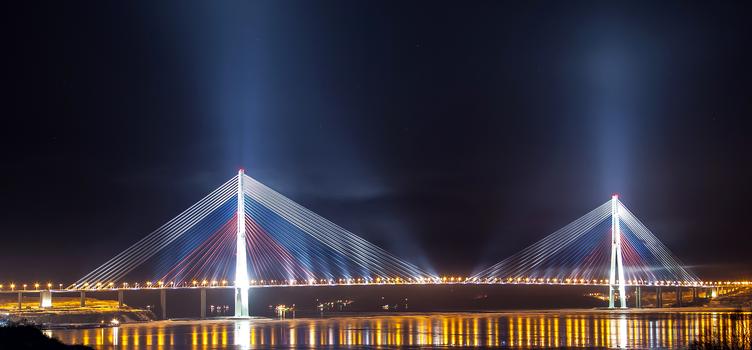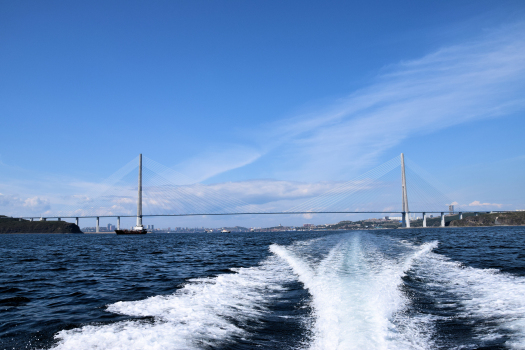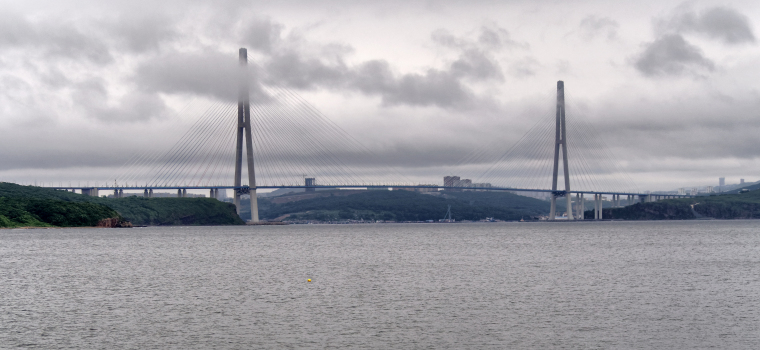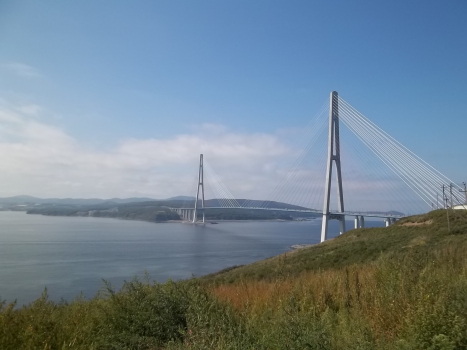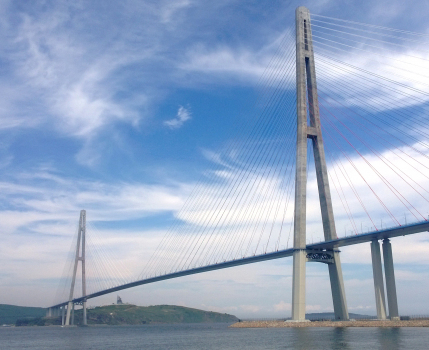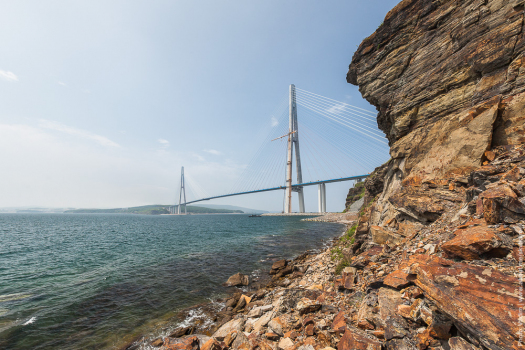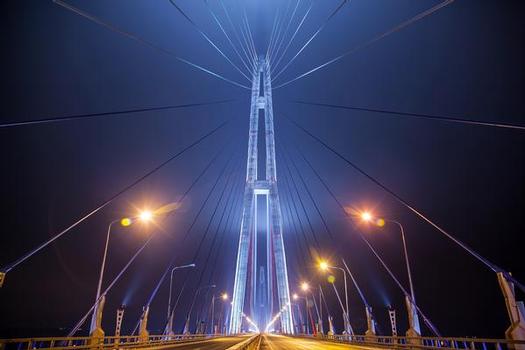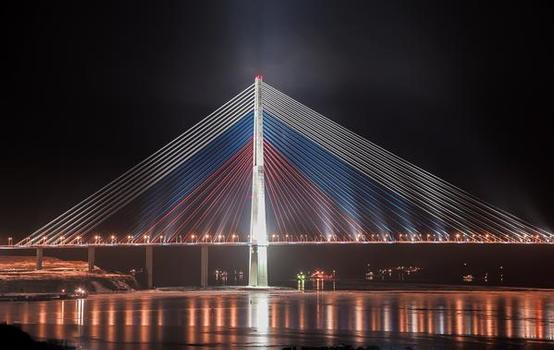General Information
| Name in local language: | Русский мост (Russky most) |
|---|---|
| Other name(s): | Russky Island Bridge |
| Beginning of works: | 2009 |
| Completion: | 2 July 2012 |
| Status: | in use |
Project Type
| Structure: |
Cable-stayed bridge with semi-fan system |
|---|---|
| Function / usage: |
Road bridge |
| Structure: |
Three-span cable-stayed bridge |
| Support conditions: |
for registered users |
| Material: |
Steel bridge |
| Material: |
Structurae Plus/Pro - Subscribe Now! |
| Secondary structure(s): |
Structurae Plus/Pro - Subscribe Now! |
| Material: |
Structurae Plus/Pro - Subscribe Now! |
| Secondary structure(s): |
Structurae Plus/Pro - Subscribe Now! |
Location
| Location: |
Vladivostok, Primorsky Krai, Far Eastern Federal District, Russia |
|---|---|
| Coordinates: | 43° 3' 23.07" N 131° 53' 51.30" E |
| Coordinates: | 43° 4' 12.96" N 131° 55' 29.72" E |
Technical Information
Dimensions
| total length | 3 100 m | |
| main bridge | ||
|---|---|---|
| main span | 1 104 m | |
| total length | 1 885.53 m | |
| span lengths | 60 m - 72 m - 3 х 84 m - 1104 m - 3 х 84 m - 72 m - 60 m | |
| number of spans | 7 | |
| deck | width | 29.5 m |
| number of lanes | 4 | |
| roadway / carriageway width | 21 m | |
| pylons | height | 320.9 m |
| stay cables | cable length | 135.77 - 579.83 m |
| length | 135.771 - 579.83 m | |
| number | 168 | |
Quantities
| main bridge | ||
|---|---|---|
| deck of main span | structural steel | 22 567 t |
| deck of side spans | concrete volume | 80 490 m³ (?) |
| prestressing steel | 647 t | |
| reinforcing steel | 8 792 t (?) | |
| piers | concrete volume | 80 490 m³ (?) |
| reinforcing steel | 8 792 t (?) | |
| pylons | structural steel | 3 394 t |
| concrete volume | 41 419 m³ | |
| prestressing steel | 133 t | |
| reinforcing steel | 10 462 t | |
| stay cables | steel for cable-stays | 3 650 t |
Design Loads
| wind resistant to | 36 m/s | |
| temperature range | -40°C — 40°C |
Materials
| piers |
reinforced concrete
|
|---|---|
| deck of main span |
steel
|
| pylons |
reinforced concrete
|
| deck of side spans |
prestressed concrete
|
Case Studies and Applied Products
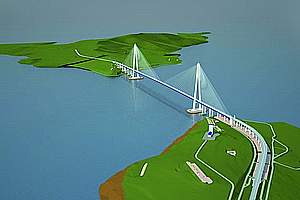
Comprehensive Structural Protection at the World’s longest Cable Stayed Bridge
Excerpt from Wikipedia
The Russky Bridge (Russian: Русский мост, Russian Bridge) is a cable-stayed bridge in Vladivostok, Primorsky Krai, Russia. The bridge connects the Russky Island and the Muravyov-Amursky Peninsula sections of the city across the Eastern Bosphorus Strait, and with a central span of 1,104 meters (3,622 feet) it is the longest cable-stayed bridge in the world. The Russky Bridge was originally built to serve the 2012 Asia-Pacific Economic Cooperation conference hosted at the Far Eastern Federal University campus on Russky Island. It was completed in July 2012 and opened by Prime Minister Dmitry Medvedev, and on September 3, 2012, the bridge was officially given its name.
Overview
The bridge to Russky Island is the world's longest cable-stayed bridge, with a 1,104 m (1,207 yds) long central span. The bridge also has the second-highest pylons after the Millau Viaduct and the longest cable stays.
The design of the bridge crossing has been determined on the basis of two primary factors:
- Shortest coast-to-coast distance in the bridge crossing location 1,460 m (1,600 yds). Navigable channel depth is up to 50 m (160 ft).
- The locality of the bridge crossing construction site is characterized by severe climate conditions: temperatures vary from –31 to +37 °C (–24 to +99 °F); storms bring winds of up to 36 m/s (130 km/h; 81 mph) and waves of up to 6 m (20 ft) in height; and ice formations in winter can be up to 70 cm (28 in) thick.
Pylon Construction
The piles were driven as deep as 77 m (253 ft) below ground and on the island side, 120 auger piles were piled under each of the two 320 m (1,050 ft) high bridge towers.
The pylons were concreted using custom self-climbing forms in pours of 4.5 m (15 ft). A crane was used on the first three pours, afterwards the formwork was completed unaided moving through the hydraulic motion of modular elements. The pylons are A-shaped, therefore, the use of standard forms was not feasible. An individual set of forms was arranged for each bridge tower. The transition between section types was carried out at summer levels at the elevations of 66.26 m (217.4 ft) and 191.48 m (628.2 ft). The use of self-climbing forms made it possible to achieve better quality and decrease the time of construction of cast-in-situ reinforced concrete structures by half as much again. The cable stays anchorage zone starts at 197.5 m (648 ft). The installation of cable-stay pairs and casting of bridge tower bodies was carried out simultaneously, dramatically reducing the construction period.
Central Span Structure
The span structure has an aerodynamic cross-section to assume squally wind loads. The shape of the span cross-section has been determined based on aerodynamic design and optimized according to the results of experimental processing of the scale model in the detailed design phase.
Welded field connections are used for longitudinal and transversal joints of the cap sheet of the orthotropic deck and lower ribbed plate. For joints of vertical walls of the blocks, longitudinal ribs, transversal beams and diaphragms, field connections are used provided by means of high-strength bolts.
Large-sized prefabricated sections for the installation of the central span were delivered by barges to the erection site and hoisted by a crane to a 76 m (249 ft) height. Here, the elements were abutted and cable stays attached to them.
Cable-Stayed System
A cable-stayed system assumes all static and dynamic loads on which the very existence of the bridge depends. Cable stays are not designed to endure the entire lifetime of the bridge, but they are repairable and have the best possible protection from natural disasters and other adverse impacts.
Parallel strand stay (PSS) cable stays consist of parallel strands of 15.7 mm (0.62 in) diameter; every strand consists of seven galvanized wires. Cable stays incorporate from 13 to 79 strands. The length of the shortest cable stay is 135.771 m (148.481 yds); the longest, 579.83 m (634.11 yds). The protective housings of the cable stays are made from high-density polyethylene (HDPE) and have the following features: UV resistance; resistance to local climate conditions of Vladivostok (temperature range from –40 to +40 °C; –40 to +104 °F) and environmental aggressiveness.
Bridge specification
Completed bridge at night, 2013
- Bridge footprint: 60+72+3x84+1104+3x84+72+60 m
- Total bridge length: 1,885.53 metres (6,186.1 ft)
- Total length incl. trestles: 3,100 metres (10,200 ft)
- Central channel span length: 1,104 metres (3,622 ft)
- Bridge width: 29.5 metres (97 ft)
- Bridge roadway breadth: 23.8 metres (78 ft)
- Number of driving lanes: 4 (two in each direction)
- Under clearance: 70 metres (230 ft)
- Number of bridge towers: 2
- Pylons’ height: 324 metres (1,063 ft)
- Number of cable stays: 168
- Longest cable stay: 579.83 metres (1,902.3 ft)
- Shortest cable stay: 135.771 metres (445.44 ft)
Comparison of the side elevations of the Russky Bridge and some notable bridges at the same scale. (click for interactive version)
Criticism
The costs and the fact of the construction of the Russky Bridge are widely criticized by the Russian political opposition. In January 2007, Vladimir Putin, then-President of Russia, stated that holding a summit in Vladivostok is a distinct possibility, and that at least 100 billion rubles would be required to prepare the city for the summit, which, at the time, was three times more than the provincial budget of Primorsky Krai as a whole. As of 2012, the cost of construction was expected to surpass $1 billion USD, and the project description on the site of the general contractor did not list project costs. Additionally, the built-in capacity of 50,000 cars per day is ten-times the existing population of Russky Island at only 5,000 inhabitants, leading to severe under-usage.
There had previously been criticism that the paved road had ended in a dead-end, a short distance beyond the bridge, during the first year after it was built. The paved road network has since then been expanded. As of 2018, the road covers the entire Sapper peninsula, about 25% of the total area of the island.
Text imported from Wikipedia article "Russky Bridge" and modified on February 11, 2021 according to the CC-BY-SA 4.0 International license.
Participants
Relevant Web Sites
Relevant Publications
- (2015): Amplitude and frequency independent cable damping of Sutong Bridge and Russky Bridge by magnetorheological dampers. In: Structural Control and Health Monitoring, v. 22, n. 2 (February 2015), pp. 237-254.
- (2019): Design and construction methods for UHPFRC bridge deck. Presented at: IABSE Congress: The Evolving Metropolis, New York, NY, USA, 4-6 September 2019, pp. 44-53.
- (2011): Longer…. Presented at: 35th Annual Symposium of IABSE / 52nd Annual Symposium of IASS / 6th International Conference on Space Structures: Taller, Longer, Lighter - Meeting growing demand with limited resources, London, United Kingdom, September 2011.
- (2013): Le pont à haubans de Russki à Vladivostok. In: Travaux, n. 896 (April 2013), pp. 98-106.
- : Putins Prestige-Brücke in die Einsamkeit der Russki-Insel. In: Frankfurter Allgemeine Zeitung, 25 Sept. 2012.
- About this
data sheet - Structure-ID
20059947 - Published on:
06/05/2011 - Last updated on:
27/01/2021

